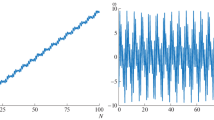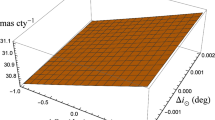Abstract
We used recently produced Solar System ephemerides, which incorporate 2 years of ranging observations to the MESSENGER spacecraft, to extract the secular orbital elements for Mercury and associated uncertainties. As Mercury is in a stable 3:2 spin-orbit resonance, these values constitute an important reference for the planet’s measured rotational parameters, which in turn strongly bear on physical interpretation of Mercury’s interior structure. In particular, we derive a mean orbital period of \((87.96934962 \pm 0.00000037)\,\hbox {days}\) and (assuming a perfect resonance) a spin rate of \((6.138506839\pm 0.000000028){}^{\circ }/\hbox {day}\). The difference between this rotation rate and the currently adopted rotation rate (Archinal et al. in Celest Mech Dyn Astron 109(2):101–135, 2011. doi:10.1007/s10569-010-9320-4), corresponds to a longitudinal displacement of approx. 67 m per year at the equator. Moreover, we present a basic approach for the calculation of the orientation of the instantaneous Laplace and Cassini planes of Mercury. The analysis allows us to assess the uncertainties in physical parameters of the planet, when derived from observations of Mercury’s rotation.


Similar content being viewed by others
Notes
F. Mignard, OCA/CNRS, ftp://ftp.obs-nice.fr/pub/mignard/Famous.
References
Archinal, B.A., A’Hearn, M.F., Bowell, E., Conrad, A., Consolmagno, G.J., Courtin, R., et al.: Report of the IAU working group on cartographic coordinates and rotational elements: 2009. Celest. Mech. Dyn. Astron. 109(2), 101–135 (2011). doi:10.1007/s10569-010-9320-4
Bate, R.R., Mueller, D.D., White, J.E.: Fundamentals of Astrodynamics, pp. 62–64. Dover publications, New York (1970)
Colombo, G.: Rotational period of the planet Mercury. Nature 208, 575 (1965). doi:10.1038/208575a0
Davies, M.E., Abalakin, V.K., Cross, C.A., Duncombe, R.L., Masursky, H., Morando, B., et al.: Report of the IAU working group on cartographic coordinates and rotational elements of the planets and satellites. Celest. Mech. 22(3), 205–230 (1980). doi:10.1007/BF01229508
D’Hoedt, S., Noyelles, B., Dufey, J., Lemaitre, A.: Determination of an instantaneous Laplace plane for Mercury’s rotation. Adv. Space Res. 44(5), 597–603 (2009). doi:10.1016/j.asr.2009.05.008
Einstein, A.: Erklärung der Perihelbewegung des Merkur aus der allgemeinen Relativitätstheorie. Sitzungsberichte K. preuss. Akad. Wiss. 47, 831–839 (1915)
Fienga, A., Manche, H., Laskar, J., Gastineau, M., Verma, A.: INPOP New Release: INPOP13b. arXiv preprint arXiv:1405.0484 (2014)
Folkner, W.M., Williams, J.G., Boggs, D.H., Park, R.S., Kuchynka, P.: The planetary and lunar ephemerides DE430 and DE431. Interplanet. Netw. Prog. Rep. 196, 1–81 (2014)
Goldreich, P., Peale, S.J.: Spin-orbit coupling in the Solar System. Astron. J. 71, 425 (1966). doi:10.1086/109947
Kaula, W.M.: Theory of Satellite Geodesy: Applications of Satellites to Geodesy, 160 pp. Dover, Mineola (2000)
Laskar, J.: A numerical experiment on the chaotic behaviour of the Solar System. Nature 338(6212), 237–238 (1989). doi:10.1038/338237a0
Margot, J.L.: A Mercury orientation model including non-zero obliquity and librations. Celest. Mech. Dyn. Astron. 105(4), 329–336 (2009). doi:10.1007/s10569-009-9234-1
Margot, J.L., Peale, S.J., Jurgens, R.F., Slade, M.A., Holin, I.V.: Large longitude libration of Mercury reveals a molten core. Science 316(5825), 710–714 (2007). doi:10.1126/science.1140514
Margot, J.L., Peale, S.J., Solomon, S.C., Hauck, S.A., Ghigo, F.D., Jurgens, R.F., et al.: Mercury’s moment of inertia from spin and gravity data. J. Geophys. Res. 117(E12), E00L09 (2012). doi:10.1029/2012JE004161
Mazarico, E., Genova, A., Goossens, S., Lemoine, F.G., Neumann, G.A., Zuber, M.T., et al.: The gravity field, orientation and ephemeris of Mercury from MESSENGER observations after three years in orbit. J. Geophys. Res. Planets (2014). doi:10.1002/2014JE004675
Noyelles, B., D’Hoedt, S.: Modeling the obliquity of Mercury. Planet Space Sci. 60(1), 274–286 (2012). doi:10.1016/j.pss.2011.07.024
Noyelles, B., Lhotka, C.: The influence of orbital dynamics, shape and tides on the obliquity of Mercury. Adv. Space Res. 52(12), 2085–2101 (2013). doi:10.1016/j.asr.2013.09.024
Peale, S.J.: Generalized Cassini’s laws. Astron. J. 74, 483 (1969). doi:10.1086/110825
Peale, S.J.: Orbital resonances in the Solar System. Annu. Rev. Astron. Astrophys. 14(1), 215–246 (1976). doi:10.1146/annurev.aa.14.090176.001243
Peale, S.J.: Measurement accuracies required for the determination of a Mercurian liquid core. Icarus 48(1), 143–145 (1981). doi:10.1016/0019-1035(81)90160-3
Peale, S.J.: The free precession and libration of Mercury. Icarus 178(1), 4–18 (2005). doi:10.1016/j.icarus.2005.03.017
Peale, S.J.: The proximity of Mercury’s spin to Cassini state 1 from adiabatic invariance. Icarus 181(2), 338–347 (2006). doi:10.1016/j.icarus.2005.10.006
Peale, S.J., Gold, T.: Rotation of the planet Mercury. Nature 206, 1240–1241 (1965). doi:10.1038/2061240b0
Peale, S.J., Yseboodt, M., Margot, J.L.: Long-period forcing of Mercury’s libration in longitude. Icarus 187(2), 365–373 (2007). doi:10.1016/j.icarus.2006.10.028
Peale, S.J., Margot, J.L., Hauck, S.A., Solomon, S.C.: Effect of core-mantle and tidal torques on Mercury’s spin axis orientation. Icarus 231, 206–220 (2014). doi:10.1016/j.icarus.2013.12.007
Pettengill, G.H., Dyce, R.B.: A radar determination of the rotation of the planet Mercury. Nature 206, 1240 (1965). doi:10.1038/2061240a0
Sanders, J.A., Verhulst, F., Murdock, J.: Some elementary exercises in celestial mechanics. In: Averaging Methods in Nonlinear Dynamical Systems, Applied Mathematical Sciences, vol. 59, pp. 363–376. Springer, New York (2007). doi:10.1007/978-0-387-48918-6_17
Standish, E.M., Williams, J.G.: Orbital ephemerides of the Sun, Moon, and planets. In: Urban, S.E., Seidelmann, P.K. (eds.) Explanatory Supplement to the Astronomical Almanac, 3rd edn, University Science Books, chap. 8, pp. 338–339 (2013)
Stark, A., Oberst, J., Preusker, F., Gwinner, K., Peale, S.J., Margot, J.L., et al.: Mercury’s rotational parameters from MESSENGER image and laser altimetry data: a feasibility study. Planet. Space Sci. (2015). doi:10.1016/j.pss.2015.05.006
Weinberg, S.: Gravitation and Cosmology: Principle and Applications of General Theory of Relativity, p. 199. Wiley, New York (1972)
Yseboodt, M.: The Laplace plane of Mercury. In: EPSC-DPS Joint Meeting, vol. 1, p. 996 (2011)
Yseboodt, M., Margot, J.L.: Evolution of Mercury’s obliquity. Icarus 181(2), 327–337 (2006). doi:10.1016/j.icarus.2005.11.024
Yseboodt, M., Margot, J.L., Peale, S.J.: Analytical model of the long-period forced longitude librations of Mercury. Icarus 207(2), 536–544 (2010). doi:10.1016/j.icarus.2009.12.020
Acknowledgments
The authors thank Jean-Luc Margot, Benoît Noyelles, Stanton J. Peale, and Marie Yseboodt for fruitful discussions, and we also thank William M. Folkner and Charles H. Acton for providing information on the DE432 ephemeris. The reviews by two anonymous reviewers significantly improved earlier versions of this manuscript. J.O. greatly acknowledges being hosted by MIIGAiK and supported by the Russian Science Foundation under project 14-22-00197.
Author information
Authors and Affiliations
Corresponding author
Appendices
Appendix 1
The Keplerian orbital elements derived from the INPOP13c ephemeris (Fienga et al. 2014) are given in Table 2. We find very little difference of the values when comparing to the DE432 ephemeris (see Table 1). The deviation for the trend \(a_1\) of the semi-major axis is about 1.7 meter per century.
In Table 3 we give values for reference frame dependent orbital elements with respect to the ecliptic (ECLIP, inclination 23.439291\(^\circ \)), Mercury orbital plane (OP), and Mercury Laplace plane (LP) at J2000.0. The rotation matrices for the transformation to the these reference frames from the ICRF are given by
The precession of the pericenter of Mercury is given by \(\varpi _1^{\mathrm{OP}}=\varOmega _1^{\mathrm{OP}}+\omega _1^{\mathrm{OP}}=575.3\,\text {arc sec/cy}\). The inclination of the orbital plane with respect to the Laplace plane \(I_0^{\mathrm{LP}}=\iota =8.58^{\circ }\) remains constant \(I_1^{\mathrm{LP}}=I_2^{\mathrm{LP}}\approx 0\). The precession of the orbit around the Laplace plane is \(|\varOmega _1^{\mathrm{LP}}|=\mu =0.109981^{\circ }/\text {cy}\).
Appendix 2
In Table 4 we list the first ten periodic terms, which were identified in the osculating orbital elements time series. Some of the periods can be assigned to planetary perturbations, e.g., Venus: \((\lambda _V)\) 0.62 years; \((2\lambda _V)\) 0.31 years; \((2\lambda _M-5\lambda _V)\) 5.66 years; \((\lambda _M - 3\lambda _V)\) 1.38 years; \((\lambda _M - 2 \lambda _V)\) 1.11 years; \((2\lambda _M-4\lambda _V)\) 0.55 years; Earth: \((\lambda _M-4\lambda _E)\) 6.58 years; Jupiter: \((\lambda _{J})\) 11.86 years; \((2\lambda _{J})\) 5.93 years; \((3\lambda _{J})\) 3.95 years; Saturn: \((2\lambda _{S})\) 14.73 years, where \(\lambda =M+\varpi = M + \varOmega + \omega \) denotes the mean longitude of the planet, respectively.
Appendix 3
The obliquity of the spin axis \(i_c\) introduces small changes in the precession and resonant rotation rates. To stay within the Cassini plane the spin axis has to precess slightly faster than the orbital plane normal. In order to compute the corrections we expand equation Eq. 33 to first order in the obliquity \(i_c\). The declination \(\delta \) and right ascension \(\alpha \) of the spin axis are then given by
and
By deriving the series in t we obtain the precession rates at J2000.0
and
For \(i_c=2.04\,\text {arc min}\) (Margot et al. 2012) this results in
The rotation rate is also slightly modified due to the obliquity. For small \(i_c\) we get
The resonant rotation rate is consequently
and with \(i_c=2.04\,\text {arc min}\) this amounts to \(6.138506841^{\circ }/\text {day}\). The introduced correction is not significant when compared to the error of the resonant rotation rate in Eq. 21.
Rights and permissions
About this article
Cite this article
Stark, A., Oberst, J. & Hussmann, H. Mercury’s resonant rotation from secular orbital elements. Celest Mech Dyn Astr 123, 263–277 (2015). https://doi.org/10.1007/s10569-015-9633-4
Received:
Revised:
Accepted:
Published:
Issue Date:
DOI: https://doi.org/10.1007/s10569-015-9633-4




